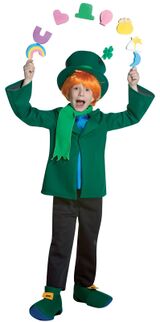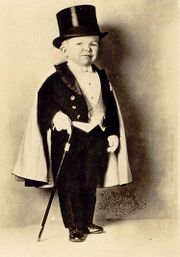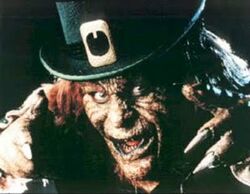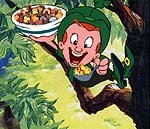Lucky Charms
“A man can make his own luck, but I'd rather have a midget.”
Lucky Charms is a cereal brand manufactured by General Mills, known for its "magically delicious" properties that give customers low blood sugar and cause them to shamefully pass out on their discounted couch. Serving as its head spokesman since the mid-1960s is Lucky the Leprechaun, a cartoon character world-famous for avoiding small children who maliciously deny him possession of the diabetic-coma inducing breakfast cereal that he is sworn to protect. Although he has lost possession of his treasured part of a balanced breakfast for short intervals of time, Lucky has always been able to reobtain the cereal by obliterating the young thieves with his rainbow phaser, set to "turn inside out."
The Early Life of Lucky[edit]
Lucky was born in Ireland in about the fifth century AD, after St. Patrick saved the Irish from the snakes. Lucky came into existence after a rainbow and pot of gold fell into a polymerization machine and created a short man. He then vowed to take vengeance on the children who made fun of him by keeping his good luck charms away from those little shits, and has been on the run with his lucky charms ever since.
From about then until the advent of "Lucky Charms" cereal (not to be confused with the advent of the Seventh Day Adventists), Lucky worked various odd jobs, mostly in the Middle East. Having served as a yak milker, an Arab prophet, a Turkish bathhouse prostitute, and a camel jockey, Lucky still wasn't realizing the wealth and fame that his friend Chocula said was to be found on earth. Lucky continued to search for this elusive contentment for many centuries, wandering throughout all the lands of this planet, incidentally spreading his beliefs in ancient superstitions to various cultures.
Coming to America[edit]
This would continue until 1959 or so, when Lucky reportedly told close friend and fellow magician Waldo the Wizard, "Aye, screw it, I'm gonna settle in America like everyone else. But how will I get there?" Being a good friend and always looking for an excuse to roundhouse kick something, Waldo wound up his leg muscles and booted Lucky to Ellis Island. After his slow recovery in a full-body cast until 1963, Lucky set out to find his fame and fortune.
When Lucky cleared customs, he headed west in a wagon train, having paid for his seat and provisions by casting out demons. Not sure what he would do with his life, Lucky considered becoming a drug dealer in Compton, but was a little ahead of his time. Along in the same wagon with Lucky rode a man who had invented a fool-proof pyramid scam involving telegraphmarketing fraud and an a yet-to-be-named breakfast food consisting of primitive sweetened styrofoam squares and pieces of recycled cardboard in the shapes of the Hebrew Alphabet. He planned on calling his creation "Kabbalah-Oh's", and presented it to the large Jewish population of New Amsterdam (later called New York. You should listen to more They Might Be Giants, you'd know this stuff. Geez). The Jewish people were not fond of the product, because square is not a Kosher shape, and thus dashed the dreams of the retired army veteran-turned-cereal creator, General Mills.
However, Lucky saw a perfect opportunity for him to cash in on the superstitious nature of the people of America and the current witchcraft obsession of the media, and submitted the idea to General Mills to make the tasteless brown mystery Hebrew letters into pictograms from ancient Satanic texts, and the square imitation marshmallows into amulets of luck. Soon thereafter, the "Lucky Charms" cereal came into existence. In addition, General Mills sold his idea for the pyramid scheme to a real-estate scammer, who uses it still to this day. Some even consider Calrton Sheets a god.
Frosted Lucky Charms: They're Magically Destructive[edit]
In 1964, Lucky and cereal entrepreneur General Mills set up a makeshift cereal production center in the basement of a home in Indiana, which would later be owned by famed skin-dress wearer and one-time Miss Indiana, Buffalo Bob. The location was a good spot to ship from, being near the Ohio River, but it just wasn't evil enough. So Lucky and General Mills moved base camp to Salem Mass., which was still heavily embattled with witchcraft and the slaughter of Native Americans. Lucky and the General hired several local witches and warlocks to speak incantations and thereby produce the cereal by magic much quicker than they could do by machine.
At the moment, this seemed like a great idea, and the money started pouring in. However, the local papers quickly picked up on the growing reports of diabetic comas and demonic possessions happening just after breakfast, and soon Lucky and General Mills were chased out of Salem by mobs of angry parents (their descendants would later treat heavy metal musicians and vacuum cleaner salesmen in a very similar manner). The breakfast duo had profited greatly by using evil forces to produce their cereal however, and didn't plan on stopping, so they relocated to an abandoned inn out west, later immortalized in The Eagles' song "Hotel California and Continental Breakfast of Lucky Charms". The title of the song was later changed, as was the verse "You cannot kill the beast, nor provide a more balanced breakfast than one including Lucky Charms."
Despite years of success using the time-honored tradition of practicing black magic to conjure the shapes of blue diamonds, purple horseshoes and green clovers from the bowels of Hell, eventually the public demanded a less demonic cereal. The General Mills company decided that they would change the Satanic pictographs into indecipherable Mandarin cursewords instead, and the public seemed okay with that. However, by this point a new wave of Wiccan magic and superstition had arisen, which wasn't nearly as scary as the old east coast Salem stuff, and the company decided to leave the marshmallow-like styrofoam pieces as symbols of luck, though they did decide to discontinue the Orange Wing of Newt and the Yellow Pentagrams, as well as recalling all packs of Instant Myan Fun, which turned your milk into strawberry-flavored sacrificial blood upon contact.
Advertisement[edit]
The box was re-designed to feature Lucky smiling and sliding down a rainbow, replacing the previous image of a Voodoo doll covered in guano, and the prize was changed from a miniature copy of The Book of the Dead and a copy of Rosemary's Baby to varied plastic garbage hawking movie releases and such.
The television advertising campaign for Lucky Charms has remained largely unchanged since the 1960s, consisting of hatemongering, anti-leprechaun children trying to catch Lucky and deprive him of his nourishing Lucky Charms. This is based on actual events that happened during a European Lucky Charms advertising tour during the Great Potato famine of Ireland. In the commercials, Lucky escapes unharmed and the children merely plot to yet again greedily steal the cereal. However, history documents the events much differently, as Lucky used his IRA military surplus phaser to make the lives of the children a short and miserable one, using his weapon on the setting "turn inside out". A single blast not only reveals all of the body's inner organs leaving them unprotected from the elements, but causes the victim to choke to death on their own body hair. It's no way to live, but a great way to die. If you're into that kind of thing. I'm not.
Lucky Charms: Less Evil, Still Dangerous[edit]
Although most of the blatant Prince of Darkness qualities have been removed from the cereal, Lucky Charms is still by no means a safe breakfast to consume. Sugar levels in the cereal are enough to throw an elephant into shock, and the brightly-colored marshmallows have caused seizures in epileptics and the mildly retarded. In addition to these proven facts (of course it's true, or else they wouldn't have let me put it on Uncyclopedia, would they?!?) there have been spy photos declassified by the U.S. government showing pallet loads of Lucky Charms being shipped out of Chernobyl, possibly explaining why the demonic possessions of yesteryear (not necessarily fun, but treatable with holy water) have been replaced by mouth tumors and birth defects (not really treatable at all). Lucky Charms have also been ironically banned in Ireland of all places, because their patented "marshmallow-power" design prevented Irish supermarket monsters Superquinn from making a cheaper "own brand" version.
Despite these public health scares, Lucky Charms has managed to stay on the market for about fifty years now, using the same basic ingredients the General Mills company started with — recycled cardboard, pure cane sugar, corn syrup, glucose, Sucralose, pure powdered carbohydrate, styrofoam, and just a pinch of luck.
| |||||||||||||||||||||





